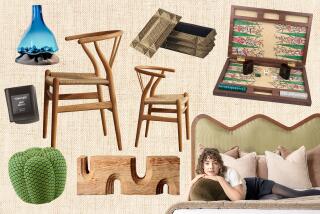DECORATING : An Honest Approach to Furnishings
Thereâs a certain naivete to the notion that how you furnish your home can change your life. Yet, itâs an idea that endures.
It dates at least to the early 20th Century, when proponents of the Arts and Crafts movement set out to cleanse the home of Victorian clutter. They substituted plain oak furniture and handcrafted accessories for Victoriana in the belief that the honesty of exposed wood joinery would encourage a preference for honesty in other areas of life--and that buying crafts would strike a blow against the factory system.
Some of these ideas are still with us, according to Janet Kardon, director of the American Craft Museum in New York and organizer of âThe Ideal Home: 1900-1920.â The exhibition contains about 200 special Arts and Crafts objects from public and private collections throughout the United States.
âWe want to show that these objects were the beginnings of a century-long movement,â Kardon says.
The show is the first of eight planned exhibitions and accompanying books that will help write the history of the rise of the decorative crafts during the 20th Century.
Taken together, whatâs on show suggests certain basic themes, such as nature as an inspiration. Woodsy colors became popular between 1900 and 1920. Nature was also the inspiration for a raft of decorative themes--embroidery on textiles, patterns for stained-glass windows and metal screens, even the shape of furniture, such as a table that looks like a leaf.
The era introduced a preference for natural finishes on wood furniture, for earthy brown and green ceramic pots, for natural textiles and for hand-hammered silver and copper bowls.
Though most home furnishings of the day were machine-made, the Arts and Crafts movement revered handmade decorative furnishings. Many of the most interesting items, such as Tiffany lampshades and vases and Rookwood pottery on display, were made by hand in small workshops where care was taken to produce something of high quality.
âThey said everything good was made by hand. Yet, if they could use a machine to make something better, they did,â Kardon says. âOne solution was to use the machines, yet add touches that looked like handwork.â
In their own day, these objects were home furnishings, not museum pieces displayed individually in vitrines.
Ideally, a Stickley chest should have its accompanying embroidered cloth, candlestick and ceramic vase. But the requirements of museum display make this impractical, the director says.
So, using reproductions currently in stores, show organizers arranged a room that looks like a real living room, circa 1900, complete with period wallpaper border. The furniture is Stickley, tiles are from Pewabic Pottery of Detroit. Accessories include embroidered curtains, period lighting and Roycroft china. Thereâs also a reprinted 1909 Craftsman furniture catalogue to browse through.
Visitors may be struck by how familiar they are with what they see. Yet, Kardon says, there are many gaps in what is known about 20th-Century decorative crafts.
A goal of the exhibit is to supply some of the missing information and to suggest a new approach to thinking about the crafts.


